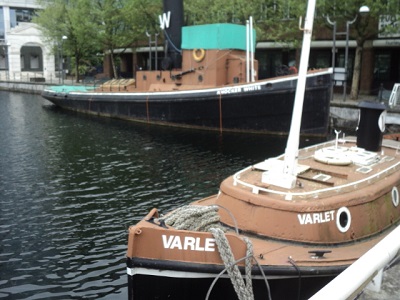Around three years ago, I posted the remarkable story of the SS Robin which has been located in the Royal Docks. I am delighted to report that plans have been announced to move the ship to Trinity Buoy Wharf, close to where she was built in 1890. Urban Space Management, leaseholders of Trinity Buoy Wharf, have agreed to maintain the SS Robin and to make her story more accessible to the public alongside other important ships.
It is planned that the collection of the SS Robin, and the tugs Knocker White and Varlet and lighter Diana will form the basis of an open air museum to help bring to life the rich heritage of the area from East India Dock Basin to Trinity Buoy Wharf. For the past few years the tugs Knocker White and Varlet have been berthed near the Museum of Docklands in West India Quay.
The SS Robin is the world’s oldest complete steam coaster and the last of her type in the world. The Dirty British Coaster was immortalised in John Masefield’s poem ” Cargoes .”
Quinquireme of Nineveh from distant Ophir,
Rowing home to haven in sunny Palestine,
With a cargo of ivory,
And apes and peacocks,
Sandalwood, cedarwood, and sweet white wine.
Stately Spanish galleon coming from the Isthmus,
Dipping through the Tropics by the palm-green shores,
With a cargo of diamonds,
Emeralds, amythysts,
Topazes, and cinnamon, and gold moidores.
Dirty British coaster with a salt-caked smoke stack,
Butting through the Channel in the mad March days,
With a cargo of Tyne coal,
Road-rails, pig-lead,
Firewood, iron-ware, and cheap tin trays.
The British coastal cargo steamships were the workhorses of the Merchant fleet in the late 19th, early 20th Century around the ports of Britain and Northern Europe. However by the 1960s they had virtually disappeared.
SS Robin is a traditional raised quarterdeck coastal cargo steamer built in Orchard House Yard near the famous Thames Ironworks on the eastern tip of Isle of Dogs and launched in 1890.
She was built to high standards regarding materials and workmanship with her hull fitted out in East India Dock. From there she was taken to Dundee to have her boiler and engines fitted. After trials she was taken to Liverpool to begin her career as a coastal steamer in 1890.
For the next ten years she plied her trade around the ports of Britain and occasionally some of the continental ports carrying the heavy cargoes such as coal, steel and china clay for which the steamers became famous for.
However in 1900, she was sold to a Spanish owner who renamed her Maria and spent the next 70 odd years going up and down the North Atlantic coast, she survived Two World Wars, once getting an escort from the French Navy to protect her from U Boat attacks.
But then at the end of a hard working life and due to be scrapped, there was another twist of fate she was recognised by the Maritime Trust as a one of a kind and in 1974 was purchased and travelled back to Britain under her own steam.
From 1974 she was given her original name back and moored in St Katherine’s Dock and her restoration began. In 1991 she moved to West India Quay where between 2003-2007 she was used as an Education Centre and Gallery.
However more structural restoration was needed, so in 2008 she went back to the coast this time to Lowestoft to prepare for her latest reincarnation in the Royal Docks where she returned in 2011.
She may still be a Dirty British Coaster of John Masefield’s poem but now she is in elite company. She’s part of the National Historic Fleet and one of only three ‘Core Collection’ (Grade 1) vessels in the capital. The other two ships are the Cutty Sark and HMS Belfast.
Although the SS Robin is considered too fragile to be able to float again, she and the other boats will be a wonderful reminder to visitors to the Trinity Buoy Wharf area of the long and glorious history of shipbuilding in the area.




David Middleton from Dundee here. Liked your write up on Robin. What is todays update 18 Aug 2017, has she moved to Bow Creek yet? Who is/are the current responsible curators/owners?
Hi David
I happened to see her the other day, she is still in Victoria Dock. I do not think the move will be in the near future because I went to Bow Creek last week and not works were going on to make way for the ship. As for her owners, this is from the SS Robin website.
The SS Robin Trust is delighted to announce a new long term future for the SS Robin at Trinity Buoy Wharf, close to where she was built in 1890. Urban Space Management, leaseholders of Trinity Buoy Wharf, have agreed to maintain the SS Robin and to make her story more accessible to the public alongside the other important ships and cultural activity already at Trinity Buoy Wharf.